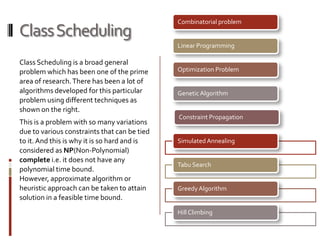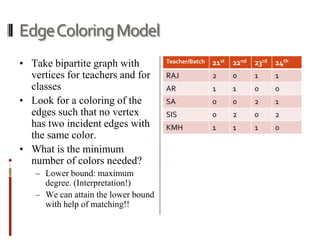Class scheduling
- 2. Combinatorial problem Class Scheduling Linear Programming Class Scheduling is a broad general problem which has been one of the prime Optimization Problem area of research. There has been a lot of algorithms developed for this particular Genetic Algorithm problem using different techniques as shown on the right. Constraint Propagation This is a problem with so many variations due to various constraints that can be tied to it. And this is why it is so hard and is Simulated Annealing considered as NP(Non-Polynomial) complete i.e. it does not have any Tabu Search polynomial time bound. However, approximate algorithm or heuristic approach can be taken to attain Greedy Algorithm solution in a feasible time bound. Hill Climbing
- 3. Problem Statement Design a simple class schedule with no conflict between a set of teachers and a set of courses with the following set of constraints: i) No same courses can be taken by any teacher or batch for a given time slot. ii) Minimize the number of time slots required and prove that it is optimum.
- 4. My Class-scheduling Approach I researched for this problem a lot and have found numerous articles, documents that were published on this topic and have seen so many variants of this Bipartite Matching problem and also various approaches such as GA(genetic algorithm), CSP (Constraint Satisfaction Problem), Combinatorial approaches have been taken. But for my purpose of creating or developing the simplest form of this class-scheduling problem, I tried to Edge Coloring develop my own algorithm, it works ! Well, for at least the specific example that Jolly madam presented in our class. I put the teachers and the courses into two independent sets and then created the Bipartite matching according to the matrix of number of courses taken by each teacher. Draw the timetable So, in a nutshell, the idea is to find the maximum Bipartite matching among teacher & courses and then do an edge coloring to find the time slot so that no two edges coming out from a vertex have the same color.
- 5. Edge Coloring Model ? Take bipartite graph with Teacher/Batch 21st 22nd 23rd 24th vertices for teachers and for RAJ 2 0 1 1 classes AR 1 1 0 0 ? Look for a coloring of the SA 0 0 2 1 edges such that no vertex SIS 0 2 0 2 has two incident edges with KMH 1 1 1 0 the same color. ? What is the minimum number of colors needed? ĻC Lower bound: maximum degree. (Interpretation!) ĻC We can attain the lower bound with help of matching!!
- 7. A Theorem Let G be a bipartite graph with maximum degree d. Then G has an edge coloring with d colors. ? Step 1: Make G regular by adding vertices and edges. ? Step 2: Repeatedly find a matching and remove it.
- 8. Edge coloring a regular graph Say GĄŊ is regular of degree d. For i = 1 to d do ? Find a perfect matching M in GĄŊ. ? Give all edges in M color i. ? Remove all edges in M from GĄŊ. (Note that GĄŊ stays regular!)
- 9. Final step Take the edge coloring c of GĄŊ. Color G in the same way: G is subgraph of GĄŊ. Time: carrying out d times a perfect matching algorithm in a regular graph: ? O(nd3) if we use SchrijverĄŊs algorithm. ? Can be done faster by other algorithms.
- 10. My Algorithm 1. Find the maximum number of degree(d) from the given bipartite Time Complexity: graph. O(nd3) 2. Add vertex and edges so that it Where n is the number of becomes a d-regular bipartite vertices(in teacherĄŊs set(t)) and d is graph. the maximum number of degree. 3. Split if there are cycles in the given Bipartite graph until there are no cycle. 4. For each color c from 1 to d ? Iteratively color different batch for set t ( the edges between them) with color c greedily. 5. Represent it as final matrix which is the solution.












